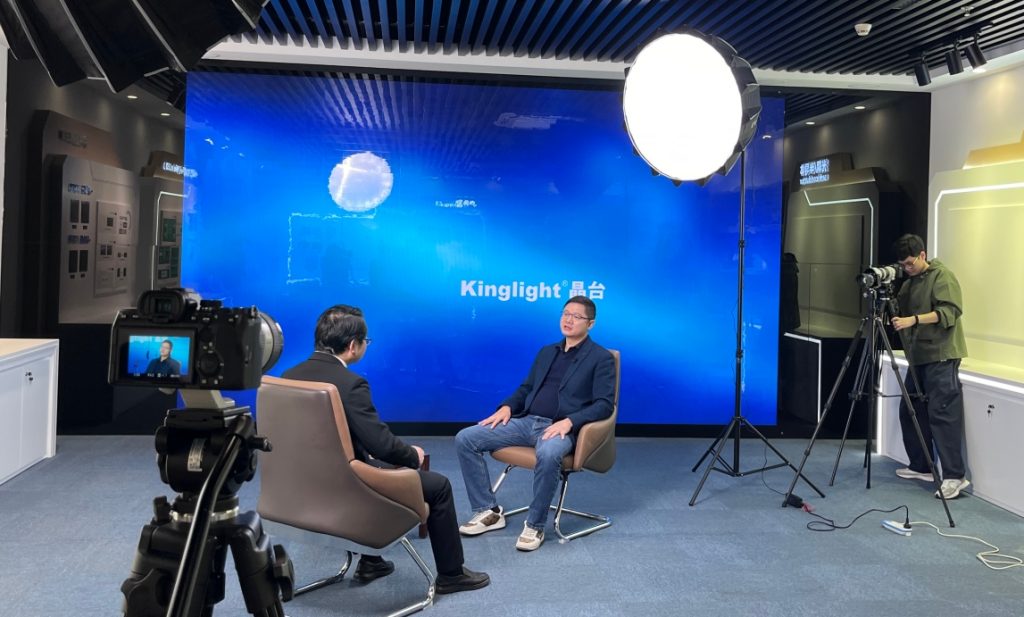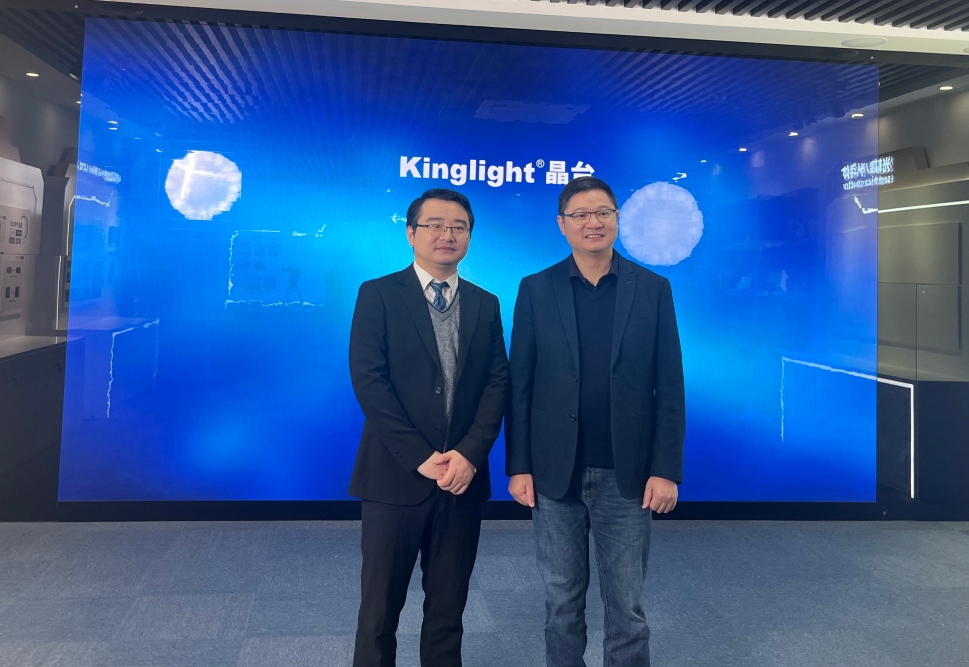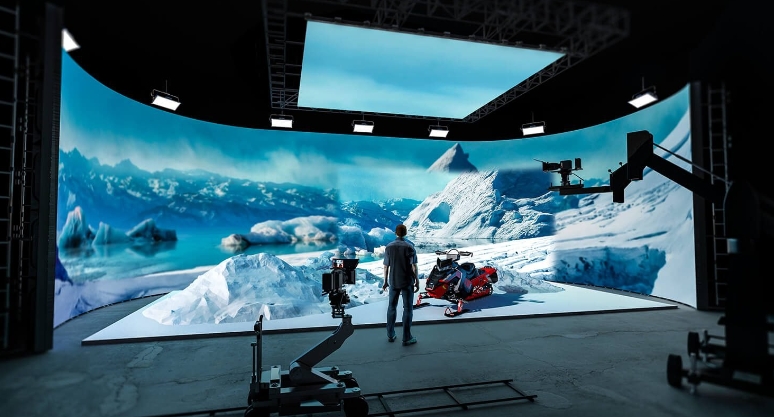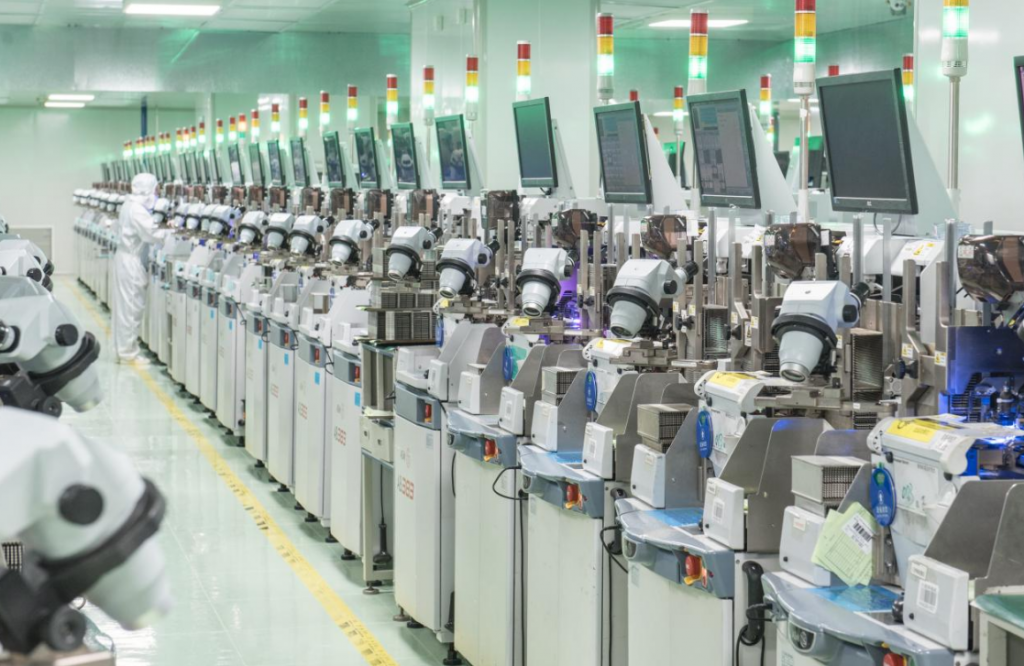Recently, Kinglight General Manager, Mr. Gongwen had a talk with LEDinside, an influential media in LED industry, over several hot topics including the trend of LED display industry, LED cinemas, LED virtual production, LED package and MiP LED technology, and Kinglight strategic plans in the future. Mr. Gong said, China LED display market are gradually recovering from the coronal virus pandemic and we will see a slow growth in 2024 as we saw in the passed 2023, and Kinglight will constantly focus on LED packaging and believes dedication is vital for the healthy growth and long term development of LED display industry. Let’s go dive into the details of this marvelous talk over China LED display industry.

Kinglight GM, Mr. Gong Wen at the interview with LEDinside
LEDinside: Good morning, Mr. Gong. Thank you very much for accepting our interview. Can you share with us your ideas and opinions over the development trend of the LED display industry in the next one or two years?
Mr. Gong: In fact, in 2019 before the breakout of corona virus epidemic, LED display industry was in a period of rapid and vigorous development. And after, the epidemic broke out and the growth of LED display industry became unstable. In 2023, the situation turned much better and gradually recovered from the epidemic.And for 2024, I think we can be a little bit optimistic, but challenges still exist.
The challenges come in two factors, one is the slow growth of worldwide economy, and the other can be that there is no new application scenario for LED displays.
According to the latest research, in 2023, China economy achieved a growth rate of 5.3%, and it is expected to be around 5% in 2024. And IMF also predicts that global economic growth in 2024 will still not exceed that in 2023. So under this macro background, I think the entire global and Chinese economy will maintain the same growth rate or slightly increase as in 2023, and there will not be much change.
And for LED display industry, there is no new application scenario developed in the past years. And the situation probably will be the same in 2024, which means that traditional application scenarios will still be the dominant market for LED displays.
No doubt in 2024, there will be a growth in worldwide LED display market since the global economy is gradually recovering from the coronal virus pandemic. But the situation is not that optimistic.

Mr. Gong, Kinglight GM had a picture with LEDinside representative.
LEDinside: Nowadays, we tend to pay more attention to some segmented application scenarios of LED displays, such as all-in-one computers and cinema screens.What’s your opinion? How does Kinglight lay out in this market?
Mr. Gong: Well, indeed, cinema is one of the hot markets for LED screens in recent years. Currently, there are more than 200,000 screens being used in cinemas across China, but among them, LED screens take a very low portion, perhaps not more than 100 units. That’s why we all eye on it.
LED displays for sure will bring a lot of advantages to cinemas. Most importantly, LED screen will explore more usages of a cinema. Unlike traditional projection type screens being used only in completely dark environment, LED screens are self-luminous. With LED screens, a cinema can be used for concerts, parties, and ceremonies in daylight, which is impossible while using a traditional projection screen.
LED cinemas open a new window to various activities and certainly will increase the profit for their owners. That’s why I’m optimistic about it.
And in fact, Kinglight have invested a lot in this sector in the past five years. We launched our first LED screen five years ago. So far, we have produced more than 300 LED cinema screens. About 1/3 of them are being commercially used, and others are being used in exhibition halls and some other application scenarios. More importantly, we constantly provide professional LED solutions for LED display manufactures.
Kinglight manufactures a wide variety of LEDs, starting from the minimal MiP 0606 to 1921 LED. 5 or 6 of them can be used for LED cinema screen project, covering screen size of 5 meters, 10 meters, 15 meters and even 20 meters large, from the smallest home theater, mini theater to IMAX giant screen theater.
We always believe that it is important to understand the needs of LED cinema screens, so our LED products perform very well in both brightness and contrast. Especially in terms of color gamut, we can achieve 100% coverage of the P3 color gamut, and we are now investing on the higher color gamut of BT2020.
In short, I think LED cinema is a quite vital market for LED displays. Therefore, Kinglight keeps working to expand in this sector.
LEDinside: Currently, what do you think are the biggest obstacles or problems encountered in the promotion of LED cinema products?
Mr. Gong: The current resistance is actually quite big. The core issue is money. Where does the money come from and who will pay for it. As we all know, the film market has never been particularly easy to do.
As for screen manufacturers, I think it may take several directions to change the situation in the future.
The first one is how to reduce the cost. For most cinemas, 10,000,000 RMB investment for an LED screen is a quite huge investment that they can not afford. So why not reduce the cost to 100,000 RMB, or even lower than traditional projection screens.
The second one is to elevate LED screen with much better performance than traditional projection screen, which will bring the audience a refreshing feeling. Let the audiences feel the difference by themselves and in return, they will to pay higher for the service.
On the other hand, the government should also provide support and invest in LED cinemas, since movie industry is an important cultural elevation program for the country. At this year’s Central Economic Work Conference, equipment updates on a large scale are being proposed.I think it’s also a good opportunity for LED cinema screen industry. So why not catch it?
LEDinside: From a purely technical perspective and long-term cost outlook, do you think these problems can be solved based on the current level of our LED industry? Or is there any chance that the long-term cost will be more competitive than existing projections?
Mr. Gong: of course it’s possible. First, the display effects of LED displays have been proved by the market for years. Second, after years of development, the costs of LED and LED screen manufacturing are incredibly lower than before.
Nowadays, cinemas usually use 2K or 4K screens, which are only 2 million pixels or 8 million pixels in terms of pixels. I think the cost can be reduced to less than 100,000 RMB. If so, the cost will be not an issue any more. The only problem is that the commercialization of LED screen for cinemas is not fast enough. If demand for LED screens increases to hundreds and thousands, the cost will be hugely reduced due to the large scale production.And it’s possible that LED displays will be as cheap as traditional screens.
LEDinside: In the next two to three or three to four years, is it possible that there will be a chance that accelerates the pace of LED display industry?
Mr. Gong: of course, in the coming years, there ought be an opportunity under the strong support from national macro-policy, the promotion of filmmakers and filming industry, and the active cooperation of LED display industry. I think LED cinema can be a hot industry if all the related industries work together. I hope, dvLED displays will eventually take over cinema screen markets.

LED powered virtual production is a hot topic and being widely used in film making industry nowadays
LEDinside: Just talked about movies. We learned that in the field of movie shooting, virtual production has been a hot topic in recent years. What do you think of the development trend of this industry? What kind of opportunities do LED companies have there?
Mr. Gong: Indeed, virtual production, from “real” to “virtual”, along with Sora, the recently launched AI tool for video generating by Open AI, gave us deep impression by their innovative approach for content creation. All these innovations are telling us that the future world will increasingly move from reality to virtuality.
In the past, filmmakers had to invest a huge amount for the background. A few years ago, we watched a movie called “The Eight Hundred”. To make the film, a new film and television base was created in Suzhou at that time and it costs 550 million RMB. And beyond the incredible investment, it takes a lot of time to the base.
Nowadays, virtual production has changed the situation. First, film production cost will be reduced since everything is produced in a virtual environment. And virtual production studio is a one-time investment, and can be re-used for other movies. And there is no more investment for other hardware. Second, virtual production saves a lot of time since it doesn’t need too much time for background setup or reduce the need to visit certain place. Filme making efficiency means a lot to cinemas. The faster, the more films being played on screen, the more profit for cinemas.

Micro pixel pitch LED screen made with Kinglight MiP LEDs
LEDinside: We have also seen that the competition among several new display technologies on the market is indeed fierce recently. Of course, as you said, we have not seen any big revolutionary changes yet. However, COB, including MiP and multi-in-one IMD, these technical forms are currently in a state of melee. I also understand that Kinglight is mainly optimistic about the direction of MiP. What do you think of the future development of these technologies? Under this trend, what kind of layout will Kinglight make on MiP? How to deal with the challenges brought about by technological competition?
Mr. Gong: I have different opinions over the competitions between different LED display technologies.Some people like to say COB will replace MiP, and others believe MiP will take over the market of SMD. They tend to use the word “replace”, which I don’t agree. Different LED display technologies suit different application scenarios. They are more complementary than competitive.
I believe in the traditional 2mm pitch (and above) LED display market, SMD definitely dominates, from the aspects of either display effect or the cost. And MiP have its own unique advantages in mini and micro pitch displays. So what is the value of COB? It should lie in high density and high definition screens,especially the screens with pixel pitch under 0.6 mm. COB will take advantage with its non-encapsulation feature and high-density capabilities. That’s why I believe they’re complementary to each other.
As for Kinglight, we currently focus on SMD and MiP. Our SMD LEDs are mostly suitable for traditional screens with relatively large pitches and a few of them are suitable for smaller pitch screens. And Kinglight MiP LEDs are designed for both mini and micro pixel pitch screens. So what about COB? Will we make COB LEDs? I bet once the market for micro pixel pitch screens, especially the ones under 0.6mm grows, we will join the COB market.
LEDinside: We notice some enterprises are expanding in COB rapidly. So how do you see such a trend?
Mr. Gong: Like I said, different companies believe in different LED display technologies. They hopes that through a specific technology, there will be a revolutionary change, and then dominate the market. However, I have always believed that each technology has its own unique advantages, and each technology also has its shortcomings. I don’t quite agree that COB technology can replace all other LED display technologies and it’s impossible that COB will become the only option of LED display market.
LEDinside: MiP, have you found some scenarios that are relatively suitable and have good growth potential?
Mr. Gong: MiP LEDs are quite suitable for small pitch screens, especially screens with pixel pitches between 1 mm and 0.6 mm.
In fact, we also provide LED for screens with pixel pitches above 1 mm. That is our Top LED and SMD. They’re cost effective and better options that can’t be replaced by other solutions.
And for screens with pixel pitches between 1 mm and 0.6 mm, Kinglight MiP LEDs are your ideal choice.
We have MC0606, MC0505, and MC0404 in different sizes for screens with 0.9, 0.7, and 0.6mm pitches respectively.
MiP LEDs have their unique advantages especially in the display effect. During the packaging stages, we strictly control the overall yield of MiP LEDs to the highest level. We do sort and bin to ensure every piece of our MiP LED provides the best display effect, while being watched either in the front or sideward. No mosaic and color consistency is quite good. More importantly, no additional calibration is needed before installation. This is the advantage that COB can not provide.
Kinglight MiP LEDs also provide great advantages in cost when compared with COB. MiP can utilize smaller LED chips, and micro sized LED chips. Therefore, the chip cost is much lower when compared with COB. Hence the overall cost of MiP LED is lower than COB.
Another advantage for MiP technology lies in the manufacturing process for us and LED screen manufacturers. For us, we can utilize the already existed package equipment to produce MiP LEDs. On the other side, MiP LEDs are compatible with traditional SMT production lines, which are friendly for LED screen manufacturers to control the cost. That means, there is no additional investment for us to promote MiP LEDs and micro pitch screens. I believe this is quite an important factor that we will consider.
Therefore, I have strong belief in MiP and it should be a very good option for micro-pitch screens market, and I look forward to more packaging companies working with downstream companies to promote the development of the micro-pitch screen market.
LEDinside: Do downstream display manufacturers accept MiP technology? Do they believe MiP LED will benefit them?
Mr. Gong: Yes, of course. And it’s easy to understand the logic. If you’re a screen manufacturer, will you reject a technology that you can handle? Are you willing to buy an entire screen and become a “second-hand” seller? Certainly NOT. But you have full control with MiP LEDs, which makes LED screen manufacturing simpler than other types of LED technology.
In fact, MiP is a win-win technology, for both LED manufacturers and screen manufacturers. Therefore, our MiP technology received great support from many downstream companies, especially small and medium-sized enterprises since its low requirement for investment. For small and medium-sized enterprises, utilizing the existing technique and process production lines is a better option for the producing of micro-pitch screens.
In 2023, Kinglight MiP LED sales volume increased five times compared to 2022. And in 2024, we expect an increase of four to five times of sales in 2023.
LEDinside: so you mean that MiP does not conflict with the already existing ecology of LED display industry.
Mr. Gong: Yeah, you are quite right. The concept of ecology is very, very important for the industry.
LEDinside: In the next few years, do you think Kinglight will still be the main driven force of MiP, or will MiP gradually become accepted by the industry?
Mr. Gong: Two years ago, only a few enterprises including us were promoting the concept of MiP, while many other LED packaging enterprises didn’t take part in. But in 2023, especially the second half of the year, large LED packaging enterprises joined the MiP family, which I think it is a symbol that MiP is widely accepted by the market.
The concept of ecology is very important. China LED display industry has experienced 20 years’ growth (or more) to today, from tens of millions RMB market value, to thousands of millions, and to around 50 billion RMB. Every enterprises in the industry contributed, including upstream LED chip factories, middle stream LED packaging enterprises, and downstream LED screen producers. It becomes a fruitful industry due to our joint efforts. I believe, professionalism makes value. Dedication and competition is the core value of LED display industry
I think it’s unhealthy if the LED display industry becomes one enterprise operation type. If an enterprise controls the whole producing procedures of the LED displays, including the upstream, middle and downstream, then there will be no competition. I mean, without competition, there is no progress. And for sure LED display industry will regress. When a business model gives up competition and cooperation, I think this business model is immature and it is difficult to succeed.
LEDinside: Currently, can MiP be switched directly and seamlessly as before, or are there some difficulties that need to be overcome?
Mr. Gong: Basically no, they are all the same, with some differences.
For example, for traditional LEd package, we need both die bonding and wire bonding procedures; but for MiP, there is no wire bonding needed anymore, only die bonding is required. Then we have to ensure the mounting accuracy of the LED chips. But this is a relatively minor technical issue that can be easily solved.
In terms of downstream applications, MiP utilizes the tape patch method, not the blue film die bonding . It only requires existing patch lines and SMT lines to produce. Unlike in the past, we might have to buy a die-bonding machine and some other things. But it’s still not enough with die-bonding machine . You’re not capable of LED package, so you need to do molding “naked” LED chips. But with MiP LED, you get encapsulated LEDs and have different options, either run them directly or mold into COB panels.
LEDinside: Do they also agree with this direction in the upstream supply chain such as key resources and LED chips? Or is the level of support and cooperation able to meet your needs?
Mr. Gong: As for now, the cooperation is very good. And for LED chip factories, there seems to be only two ways to carry on.
LEDinside: One is vertically integration, and the other is to transform, right?
Mr. Gong: Yes, it’s the same as what I just said. Breaking the current business model will not achieve more valuable development. LED chip manufacturers also have very clear ideas for the future development of display technology, so they recognize MiP technology very much. They think this route is right. In terms of the overall cooperation, we are also very grateful to LED chip manufacturers for their support to the entire industry, including their continuous challenge to the limits of chips and the continuous introduction of smaller-sized Micro-level chips for use in our MiP technology products. Their technical team has also been working with LED packaging companies, especially Kinglight, to study how to make better use of LED chips. In short, I think the communication between upstream LED chip factories and downstream LED packaging plants is very sufficient, and the cooperation is also close. I believe that with such strong cooperation, the cost of MiP LEDs will further reduce and be reflected in downstream screen manufacturing. And eventually, the advantage of scale production will be amplified.

Kinglight production line for wire bonding of LED packaging
LEDinside: Mr. Gong, I’ve one last question to ask. LED display industry has indeed been in the process of reshuffling in the past few years. Many companies have begun to make new plans, including joining some upstream and downstream companies, and even entering industrial chains that did not belong to them through mergers and acquisitions. Kinglight has always positioned as a professional LED packaging enterprise, including the MiP technology, which is actually operating at a cooperative way with both upstream and downstream manufacturers without changing the industry structure. I would like to know what new ideas or new plans Kinglight will have under this trend?
Mr. Gong: In the past ten years, Kinglight has always served as an independent professional LED packaging company. And it will be the same in the future. Kinglight will continue to operate as a professional enterprise in LED packaging and make reliable LEDs for screen displays. We believe in the power of division of labor and the power of expertise, so we will never break the existing division of labor in the entire market. We will follow our professional route, achieve the ultimate in LED packaging, and cooperate with the development of our upstream LED chip industry. At the same time, we must serve the downstream clients well and take the responsibilities that an independent packaging company should bear. In the next three to five years, Kinglight will continue to focus on LED packaging.
LEDinside: In the next two years, there should be a chance for us to see whether it’s the vertically integrated enterprises or the ecological type, I mean, the more dedicated companies like Kinglight will do better in either MiP or COB.
Mr. Gong: Yes, and I believe in our decision and dedication will eventually pay.